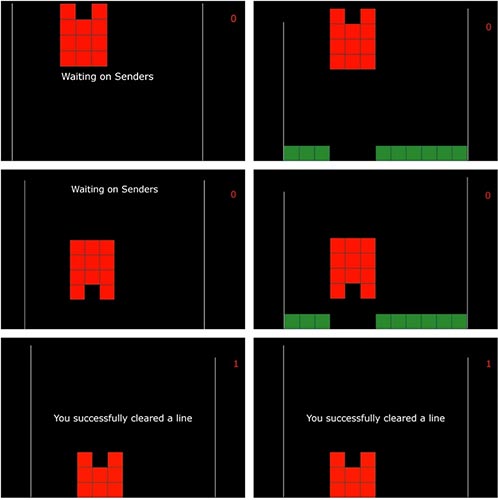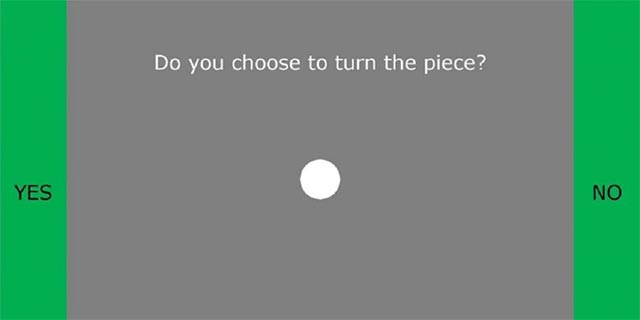Researchers invented a method that allows playing a puzzle game through brain waves
A team of scientists from Washington University and Carnegie Mellon University have successfully developed a method that allows many people to participate in Tetris (legendary 'puzzle game') without sports. Manual. Instead, the player controls the game blocks through thinking.
Researchers, Linxing Jiang, Andrea Stocco, Darby Losey, Justin Abernethy, Chantel Prat and Rajesh Rao created this interesting gaming interface, and named BrainNet. According to the scientists, this is one of the first non-invasive direct brain interaction interfaces on the world of many people involved, helping to solve the problem of cooperation in titles. Games or tasks require fast decision-making capabilities of many different individuals. Basically, BrainNet allows connecting the brain signals of 3 individuals to sit in separate rooms and thereby help them work together, make decisions for a specific problem in the school. This match is playing puzzle game.
- Insert the photon into the empty space inside the diamond
 Classic Tetris puzzle game
Classic Tetris puzzle game
To prove the effectiveness of BrainNet interface, the research team gave volunteers to participate in the classic Tetris puzzle game. If you do not know, for this game, there will be 7 types of bricks: I (vertical), J, L, O (square), S, T, Z. In which each block is made up of 4 Small squares lined up together. We can treat those bricks as different sized rectangles. The player's task is to move the falling blocks slowly down to fill all the spaces below. Any place that has been blocked does not move to that location. The player places the blocks so that the block fills a horizontal row to score points, then the horizontal row will disappear.
- The Pentagon successfully developed a laser that identifies the object through the heartbeat
 BrainNet experimental diagram
BrainNet experimental diagram
In this special version, all 3 players will work together to conquer the game. They are divided into groups of 2 'senders' (senders) and 1 'receivers' (receivers). 'Recipients' are the only players who can really control how the bricks fall, however they will not be able to see the bottom of the screen to indicate how the bricks will need to be rotated and flipped. . Meanwhile, 'sender' can see the bottom part of the screen, but cannot control how the bricks fall. Thus, the sender is responsible for observing each block and then answering the question of how to rotate and flip the shape.
- Manufacturing electric cables from plastic waste - The great plan for the situation of plastic waste pollution in the world today
 How to conduct testing
How to conduct testing
In fact, people are completely incapable of 'inheriting thought', ie, transmitting thoughts from one person to another directly to each other through the brain, which is the reason that motivates researchers. create this brain wave-based communication model
Back to the test. The sender will be provided with 2 options of 'yes' and 'no' right on the screen, and will be required to really focus to choose the right answer. The options on the screen will vibrate with light at many different frequencies. This allows an EEG headset device to clearly identify the answer the sender is focusing on by measuring their brain response.
After that, the system will transmit the information obtained through the internet connection to a device that can flash light in the recipient's eyes, indicating which answer has been selected. Then the recipient chooses a final answer by focusing on the 'yes' or 'no' options similar to the way the sender did.
- Smart light model can transfer internet data through light at speeds up to 250Mbps
 Participants will have to choose 'yes' or 'no'
Participants will have to choose 'yes' or 'no'
Next, the researchers intervened a bit in the experiment by reversing one of the sender's answers to see if the recipient caught up with the change and actually realized that 1 in 2 people sent has misunderstood the signal. Scientists believe that like many social networking sites, BrainNet allows recipients to learn to trust the sender by determining which information from which sender is more reliable. In this case it is only based on information that is transmitted directly to their brain.
This research has opened up an opportunity to apply extremely rich in practical use. Researchers believe that BrainNet can fully scale up to create a global network of brainwaves. This can lead to cooperation and the ability to interact almost without barriers between people and people, like a 'brain-only social network'.
- For the first time in history, scientists successfully connected the human brain to the Internet
In addition, the research team also hypothesized that people could use this kind of interface to learn how to filter bad information that affects the morale caused by negative agents - possibly by broadcasting Develop an instinctive method to find out which information is not suitable for yourself.
You should read it
- First confirmation in the world: Having a brain tumor caused by using too many mobile phones
- How to download Wuthering Waves, Wuthering Waves APK
- Brain Puzzle answer level 1 - 70 (updated continuously)
- Artificial intelligence algorithms read human thoughts
- Synthesis of answers game Brain Up
- You are often teased as the 'goldfish brain', do not be sad this indicates you have a brain that works very well
- Answers to Test Brain Level 1 to 60 (updated continuously)
- How does daily activities affect the brain?
May be interested
- First confirmation in the world: Having a brain tumor caused by using too many mobile phones
 the court in italy has recently concluded that a man has been suffering from a brain tumor due to excessive use of mobile phones.
the court in italy has recently concluded that a man has been suffering from a brain tumor due to excessive use of mobile phones. - Please download QUBE 2 and Layers of Fear, two great puzzle games, horror games are free
 on epic store, there is a free gifting program for the role-playing horror game layers of fear, priced at $ 7.99 and puzzle adventure game qube2 priced at $ 8.99 until the end of october 31.
on epic store, there is a free gifting program for the role-playing horror game layers of fear, priced at $ 7.99 and puzzle adventure game qube2 priced at $ 8.99 until the end of october 31. - TOP best escape room puzzle game on phone
 puzzle games are probably one of the most loved and most challenging game genres. when it comes to this genre, the room escape puzzle will definitely be the most attractive game.
puzzle games are probably one of the most loved and most challenging game genres. when it comes to this genre, the room escape puzzle will definitely be the most attractive game. - Let's train the eye with the 'brain damage' puzzle pictures below!
 let's explore the mysteries inside these puzzle pictures!
let's explore the mysteries inside these puzzle pictures! - The Witness offers - an extremely attractive adventure puzzle game for $ 13.99, which is free
 the witness is a puzzle game that explores the fascinating open world by owning a super-wide map.
the witness is a puzzle game that explores the fascinating open world by owning a super-wide map. - Download Monument Valley 2, a puzzle game with beautiful graphics is now free
 monument valley 2 is a famous puzzle game with extremely addictive brain damage, artistic design style and curious storytelling.
monument valley 2 is a famous puzzle game with extremely addictive brain damage, artistic design style and curious storytelling. - Answers to Test Brain Level 1 to 60 (updated continuously)
 this is the brain test all levels answers, the easiest brain test solution to support you when you encounter difficulties with brain test's conundrum.
this is the brain test all levels answers, the easiest brain test solution to support you when you encounter difficulties with brain test's conundrum. - All Answers Brain Blow game
 do you think no brain hacking quiz games can make it difficult for you? try brain blow and you will definitely have to find the answer brain blow game that tipsmake provides.
do you think no brain hacking quiz games can make it difficult for you? try brain blow and you will definitely have to find the answer brain blow game that tipsmake provides. - Download Deus Ex GO, a great puzzle game for both Android and iOS, is free
 deus ex go is a unique and creative turn-based puzzle game. the context of the game is the deus ex universe, a future world, where science and technology have grown tremendously, the machines are used to transplant / replace parts of the human body.
deus ex go is a unique and creative turn-based puzzle game. the context of the game is the deus ex universe, a future world, where science and technology have grown tremendously, the machines are used to transplant / replace parts of the human body. - TOP most attractive escape puzzle game on PC
 for puzzle enthusiasts, escape room games always have a strong appeal. experiencing this game genre, players will have to stretch their brains, use their logical reasoning ability to find clues and escape from any location.
for puzzle enthusiasts, escape room games always have a strong appeal. experiencing this game genre, players will have to stretch their brains, use their logical reasoning ability to find clues and escape from any location.










 Google will launch Fast Share to replace Android Beam and compete with AirDrop
Google will launch Fast Share to replace Android Beam and compete with AirDrop The Pentagon successfully developed a laser that identifies the object through the heartbeat
The Pentagon successfully developed a laser that identifies the object through the heartbeat Insert the photon into the empty space inside the diamond
Insert the photon into the empty space inside the diamond Oracle launched an autonomous database exclusively for business customers
Oracle launched an autonomous database exclusively for business customers Oppo reveals selfie camera cluster under the world's first screen
Oppo reveals selfie camera cluster under the world's first screen DisplayPort 2.0 officially launched, supporting dual 8K display at 120Hz
DisplayPort 2.0 officially launched, supporting dual 8K display at 120Hz